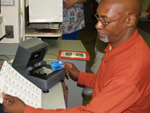Patient information system saves money
by Mary
Helen YarboroughPublic Relations
A new system used to track and monitor patient information for clinical use is being tested in one of the intensive care units (ICUs), and already shows promise in maximizing efficiency and accuracy, and saving time for support staff.
 Ronald Bradley
compares sheet of labels with labor-intensive addressograph.
Ronald Bradley
compares sheet of labels with labor-intensive addressograph.The Form Fast Project, implemented by Hospital Information Services, replaces a credit card-size patient information label, that was used to manually stamp each patient record. The new system is computer-generated and produces a sheet of 30 labels that are peeled off and placed on the records that update and accompany a patient’s chart from one unit to the next. The labels also contain bar codes that can be quickly scanned for patient information.
Regina Dell, manager of the hospital’s Health File Maintenance program, said the program, as a pilot, was launched March 12 in the surgical trauma ICU (STICU) and eventually will be used throughout the hospital.
“Though other areas are using the blue card, it will be phased out with the form fast system,” Dell said, adding that the new system also will save money. “We estimate the new system will save about $145,000 a year that was used to produce the plastic blue information cards.” One addressograph machine will remain on each unit to allow physicians to stamp the prescriptions with the physician identifier information.
Cindy Fuda, R.N., chaired the pilot project committee. She said that everyone who has used the new system is relieved by it. “The patients are not going to know the difference [between the blue card and labeling system],” Fuda said. “The efficiency is gained by the nurses.”
Previously in STICU, the dozens of blue cards had to be punched on an “addressograph,” which resembles a credit card swiping machine. “It’s loud and clunky,” Fuda said. “Now you just peel the labels off of the sheet and place them on records, where [before] you had to stamp each one.”
Ronald Bradley, a STICU secretary, said the new system has made his job much easier.
“I have to prepare the nursing notes every day,” Bradley said. “It used to take 20 minutes. Now it takes less than 10 minutes. Generating these labels is just a stroke of a key.”
The system also has enhanced accuracy and greatly diminished mis-labeling, Bradley said. “Mislabeling has been cut to almost nothing,” he said. The bar codes also help medical techs gain critical patient information more quickly.
When a physician entered the room and asked, “Where’s the blue card?” Bradley announced, “There are no more blue cards.”
Friday, April 6, 2007
Catalyst Online is published weekly,
updated
as needed and improved from time to time by the MUSC Office of Public
Relations
for the faculty, employees and students of the Medical University of
South
Carolina. Catalyst Online editor, Kim Draughn, can be reached at
792-4107
or by email, catalyst@musc.edu. Editorial copy can be submitted to
Catalyst
Online and to The Catalyst in print by fax, 792-6723, or by email to
catalyst@musc.edu. To place an ad in The Catalyst hardcopy, call Island
Publications at 849-1778, ext. 201.